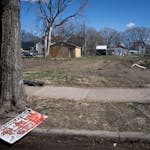Students missed nearly three weeks of classes because of a teachers strike. The superintendent announced he is leaving the district this summer. A school board member resigned, citing broken trust. And the head of human resources stepped down.
That's all come within the last four turbulent weeks for Minneapolis Public Schools. The strike exposed and exacerbated tensions in the district, revealing division and dysfunction just as a new wave of parents and community members tuned in, wondering what the strike would mean for their own families. They watched as the conflict escalated, frustration built and misinformation and mudslinging spread online.
"I think what a lot of parents are worried about is, there is such a culture of mistrust, and such a culture of disrespect that I see from the district, towards teachers and families," said Angela Denker, whose two sons attend Lake Harriet Community School. "And I think that led to a lot of the — rancor, I think, is one word I use — within the district that was really difficult to see."
On Tuesday, the day that students returned to class, they saw a school board meeting derailed by students who said they felt unheard. By the end of that meeting, the superintendent had walked out. Frustrated by his absence, among other issues, two school board members also left.
One of those board members, Sharon El-Amin, said she hopes the board can come together and the district can improve its communication and engagement with the community.
"All eyes are on the district right now," she said. "I'm not saying every [board member] is going to think the same way, but we have to be able to come together."
Board Member Nelson Inz agreed, saying the board has to focus on its mission as public servants now tasked with appointing new leaders.
"As a person, I need to not let my personal feelings about all the damaging things that have been done get in the way of fulfilling my duty to my community," he said.
The board still has to consider the tentative agreements that ended the strike. The costs of the deal have not been made public, but they include raises for teachers and education support professionals, class-size caps, more mental health supports for students and protections for teachers of color.
Strained relationship
The dynamics that led to the Minneapolis teachers strike have played out in urban districts from Chicago to Los Angeles. After decades of stagnant wages, diminished funding and sharpened scrutiny, teachers unions in the last few years — even before the COVID-19 pandemic — began to more often use strikes as a tool. And they've brought community priorities, from social workers to affordable housing, to the negotiating table.
"A lot of times when people in the public think about teacher unions, they think about, 'Well, these teachers are just looking to get better salaries for themselves,' " said Jon Shelton, associate professor of democracy and justice studies at the University of Wisconsin-Green Bay. "But this has been a conscious embrace of this strategy, and it's because many of these unions understand that if they're going to be able to teach more effectively, their students need to have the support that they need to succeed in the classroom."
The pandemic compounded those needs and further strained the relationship between unions and districts.
"Bargaining can be difficult to begin with when you've got a few issues," said Robert Bruno, professor of labor and employment relations at the University of Illinois. "But if you then layer in issues that develop during a public health crisis — or that the public health crisis exposed — you're going to put people under a lot of stress, and it's going to make bargaining harder."
In Minneapolis, both sides repeatedly claimed the other refused to sit at the bargaining table.
The district said the union's demands exceeded their financial limit, reiterating the district's projected $21.5 million budget shortfall, despite the use of $75 million in one-time federal relief money. Still, the union held out, insisting the district needed to reprioritize its money.
Gayle Smaller, a north Minneapolis parent who interviewed strike stakeholders on behalf of an outside labor union, said he thinks the strike "really forced the district to look at how they do business differently, and how they value staff differently."
But at the same time, he said, he believes the district gave as much as it could early on — and that ultimately, the strike drove a wedge between the union and the district, and also created divisions within the district and individual schools.
"No one feels like any other person was supporting them," Smaller said.
'Pain and division'
The animosity left a bad taste in the mouths of parents already exhausted by nearly two years of distance learning and the upheaval of school redistricting.
Families were leaving the district before the strike — creating financial pressures that contributed to the negotiations breakdown. Parents say they worry that will continue, but they are also weighing whether to leave themselves.
Shiva Mittal, whose two children attend Seward Montessori School, said he was disturbed by district communications during the strike that seemed to place the blame on teachers, and feels that he and other parents remain in the dark about the district's goals and plans.
But moving his kids to another district doesn't feel like a solution.
"If ... it was just academic success that we cared about for our kids and the exposure to a more diverse environment was not as important, we might just say, 'OK, it's time to move to Edina, I guess,' or 'It's time to move to Hopkins,' " he said. "But I don't think that would get us what we're looking for for our kids, either."
Kristy Wesson, the mother of Minneapolis school board student representative Jake Wesson said she knew he was stepping into the role at a volatile time, but she never expected tensions and hurt to reach such a fever pitch.
Still, she said Jake is learning some important lessons: Many things can be true at once. People in a community bring different experiences and perspectives. Issues within the schools are complex, layered and often longstanding.
"It's clear there is a lot of pain and division in our community right now," Jake Wesson wrote in a statement. "Students are the ones to ultimately experience the impact of these decisions and [fellow student representative] Kennedy [Rance] and I are committed to keeping student voices at the forefront of the discussion."




